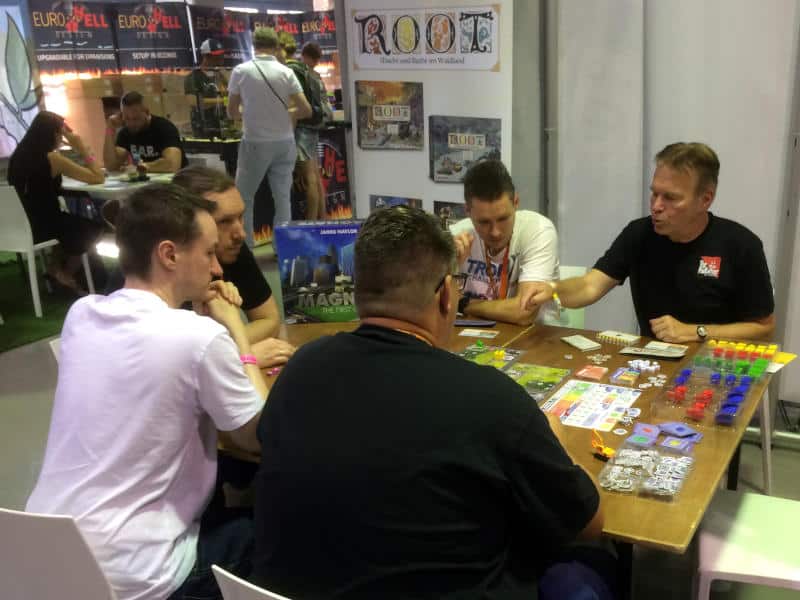It’s clearly Bez month, because here is another article inspired by her. This time she wanted to know my thoughts on giving fair credit in games. So let me see if I can rise to the challenge.
Listen to the Audio Version
Intro Music: Bomber (Sting) by Riot (https://www.
Music: bensound.com
License code: FUMFF5HVAGE6NN4Y
I think that in recent years, publishers have become better at crediting the people who worked on a game. Where a few decades ago board game boxes would only show the name of the game and the publisher’s logo, now you can usually see the name of the designer as well as the illustrator or graphic designer and sometimes even the developer. Rulebooks now also often list playtesters and other people who helped make the game a reality at the end. Apparently, some games even show the name of the manufacturer.
So while things are getting better and more people at least get a mention, there isn’t much consistency from game to game and between publishers. I reckon there is no consensus on who warrants a credit and where that credit should appear.
Designers
I think we probably all agree that the names of the designers have to be shown prominently on the front of board game boxes and be one of the first names listed in the relevant section of the rulebook that credits people and companies who worked on the game. It seems to be the minimum standard in our industry.
In fact, with the rise of independent publishers, where the designer and publisher are usually one and the same, it is a given, even if the designer’s name is hidden behind the brand name they have given their publishing outlet. So while we do see Bez‘s name listed on her games, her company Stuff by Bez is possibly better known and is synonymous with her as a person.
There are also situations where a group of designers will never reveal who amongst them actually worked on a specific game, instead always crediting the group as a whole using the group’s name. I suppose some people don’t like to be mentioned by name. They see themselves as part of a group who collectively work on something. So even when not necessarily everyone contributed to a specific game, they still all function as a team.

Get yourself a wooden Tabletop Games Blog dice tray.
Each tray is the perfect size to roll your dice, and with the soft mat, it’s really quiet, while the wooden frame makes it wonderfully sturdy.
Artists
The next names many of us will expect to see printed prominently on the front of a game box are those of the illustrators, graphic designers or other artists. I think many of us have started to be able to recognize certain illustrators’ styles. Some illustrators have become celebrities within our hobby in their own right, separate from the designers or publishers they usually work with. I mean, just think of Kwanchai Moriya or Roland MacDonald. Their art style isn’t only very distinctive, but they are also very well known in our hobby.
On the other hand, many publishers rely on only one or two illustrators for their games. Osprey Games with Roland MacDonald or Spielworxx and Harald Lieske are only two examples. So they almost don’t need to print the illustrator’s name on the box, but of course, they do.
Yet, when it comes to the people who ensure that action spaces on a game board or the layout of your player mat are easy to see and make sense just by looking at them, it’s often the case they don’t get mentioned. Graphic designers’ work is hugely important to allow us, the playing public, to make playing the game easier. We all probably know of examples where the beautiful artwork of a highly detailed game board makes it impossible to see where to place your workers or where symbology has gone mad and is more confusing than helpful. Sometimes graphic designers do get mentioned on the cover of a board game box, but at the very least, they should appear alongside the illustrator in the rulebook’s credit section.

Developers and Play Testers
Another group of important people are the developers. They are probably not so common in indie publisher circles, but certainly big, corporate publishers have at least one developer on hand to turn a great game into an amazing one or to tweak a game’s setting or theme to fit into a publisher’s product catalogue more seamlessly.
The work of a developer can be very light touch or it can be really impactful. Either way, it’s these people who really polish a game and make it shine. Without them, some games would probably fly under the radar of many of us and not become very popular. So they deserve to be credited for their work.
Some games do indeed have the developers’ names printed in a prominent location on the front of the game box. More and more rulebooks also list them among the other credits and often near the top of the list, which is great to see.
Play testers are another important group of people, whose input can have a huge influence on the success of a game. Whether these people are employed by the publisher, are part of a group that meets regularly or are part of targeted playtest sessions arranged on behalf of the designer or publisher, their names also deserve a mention.
Again, most rulebooks do list their names nowadays and sometimes they even appear on the back of a board game box. That’s especially true for indie publishers and for games that were produced with the help of a crowdfunding campaign.
More People
However, there are even more people who will have helped to make a game a reality. From the marketing team to the rulebook writers to the translators to the manufacturer to the logistics firm to lots of other people, there are probably dozens upon dozens of people involved. It might not be quite as many people as you see names in the end credits of Hollywood blockbusters, but I reckon it is still a lot.
While it feels like it would be great to list them all, at least the names of the companies involved, most rulebooks don’t reserve space for film trailer lengths of names. Crediting all these people would certainly be wonderful and I would be honoured to have my name printed in a game’s rulebook somewhere, but I think we have to draw the line somewhere. Or maybe we don’t.
This is where it gets a bit tricky and I reckon you will have different opinions to mine. So please let me know in the comments below what you think. Is the industry doing enough to credit the people who make those amazing games a reality? What names should get a credit, but don’t? Where should they appear? Are there people who you think shouldn’t be shown or at least take more of a backseat? I’d love to hear what you think.
For behind-the-scenes updates, branded merchandise, and more, please support the blog.
Useful Links
- Stuff by Bez: http://www.
stuffbybez. com/ - Kwanchai Moriya: https://www.
kwanchaimoriya. com/ - Roland MacDonald: https://rolandsrevenge.
com/ - Harald Lieske: https://tabletopgamesblog.
com/ 2020/ 12/ 23/ harald-lieske-let-me-illustrate/ - Let me illustrate podcast series: https://tabletopgamesblog.
com/ let-me-illustrate/
Audio Version
Intro Music: Bomber (Sting) by Riot (https://www.
Music: bensound.com
License code: FUMFF5HVAGE6NN4Y
Playlist
These are the songs I listened to while I was writing this topic discussion article:





